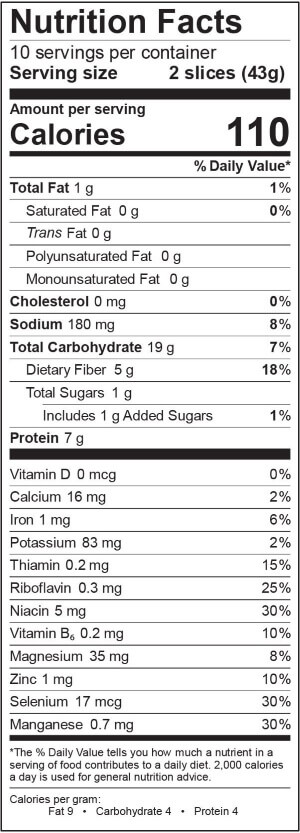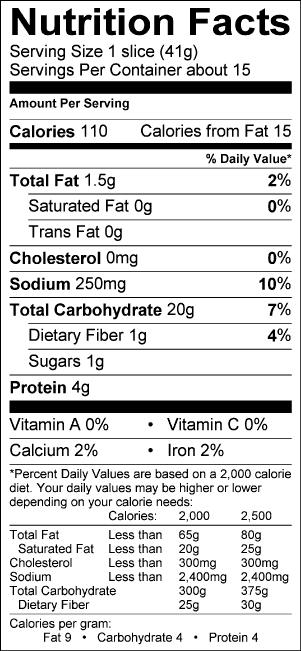Today I offer you a couple of helpful guidelines for whole grains developed by two experts in plant-based living. Michael Greger MD is a wonderful source of information on healthy lifestyles. He runs a website called nutritionfacts.org where you can find short entertaining and educational videos covering a vast range of topics of interest to anyone trying to live a healthy life. All of his information is based on good scientific evidence revealed by well-designed studies. In his video, “The Five to One Fiber Rule” he offers a very simple and useful method of evaluating the grains that you eat. Brenda Davis RD is a registered dietitian who is a public health nutritionist, academic nutrition instructor and featured speaker and has written numerous books on plant-based eating. She uses a “Hierarchy of Whole Grains” to help to choose the healthiest grain to eat.
Grains are very nutritious foods. They are an excellent source of both soluble and insoluble fiber. People who eat lots of whole grains live significantly longer lives (7). This is an effect of grains themselves; it occurs independently of other healthy eating and lifestyle habits. There is also much scientific evidence that recommends eating a higher amount of grains and dietary fibre in general as a way to reduce the risk for diabetes (7) and some cancers (9). Fiber from grain in particular is associated with lower rates of cardiovascular disease and coronary heart disease (4,5). Studies have illuminated the decrease in heart disease risk as 9% for every 7 gm of additional fiber eaten daily (4). Grain fiber reduces inflammation; each daily serving of whole grain reduces CRP concentration by 7% (CRP rises in response to inflammation and can be used as a measure of inflammation) (6,8). In general, as fiber intake rises, the risk of metabolic syndrome is reduced (3), body weight goes down and constipation is no longer a problem. Last but certainly not least, fiber feeds our good gut bacteria (10,11).
With all these benefits of whole grains, it would be good to know that we are actually eating “whole grains”. It is not easy to determine by looking at a bread or a cereal product just what ingredients have gone into them. The word “whole” at the front of “grain” on an ingredient list does not tell you the complete story either. A grain may start out whole but processing during the making of the product can turn this “whole grain” into anything but. In like manner, whole grain listed as the first ingredient of a product can be equally misleading.
During processing of a grain, it is broken down into gradually smaller pieces. The more a grain is processed, the more nutritional benefits it loses. This is where Brenda Davis’s “Whole Grain Hierarchy” comes in handy. As you progress down this hierarchy, a grain becomes gradually more processed, increasing the surface area of the grain so that nutrients are lost and the myriad of health benefits that a grain offers disappears (12).
Brenda Davis’s Whole Grain Hierarchy (12);
Intact whole grains are the healthiest form of grains. Intact grains remain just as they were on the plant. They are not processed in any way. Examples are oat groats, quinoa, brown rice, red rice, buckwheat, barley, wheat berries, kamut berries and spelt berries.
Cut whole grains are grains that have been cut in two or three places. They are almost as healthy as intact grains. Examples are steel cut oats, bulgar wheat, Red River Cereal and 12 grain cereal.
Rolled whole grains have been processed through rollers, increasing the exposed surface area and allowing more leaching of nutrients. However they still retain most of their healthy characteristics. Examples are oatmeal, rolled quinoa and rolled buckwheat.
Shredded whole grains have been shredded into smaller pieces still. An example is shredded wheat.
Ground whole grains are flours that have been processed into very small pieces. In breads, the lighter and fluffier the bread, the less healthy it is. Look for heavy breads full of grain pieces. Look also for sprouted whole grain breads – grinding sprouted grain results in more nutrients in the final product. Examples of ground whole grains are whole wheat flour, spelt flour and buckwheat flour.
Flaked whole grains are processed so extensively that they fall from the realm of healthy foods. They suffer from an extra liability from extra ingredients such as oils, salt and sugar that are added to the final product. Examples are cold flaked cereals such as bran flakes.
Puffed whole grains are the bottom of the barrel when it comes to whole grains. Examples are rice krispies, puffed wheat and brown rice cakes. Unfortunately rice cakes are so highly processed that practically no nutrients remain.
Finally we get to Dr. Greger’s 5:1 Rule – a quick and easy way to tell if a product is actually “whole grain” (1). The strategy is to look at the ratio between carbohydrates and dietary fiber in a particular product. This information is easy to come by because it is all itemized on food labels. So here’s what you do as you search your local grocery store for healthy products. Find the number of grams of carbohydrate in the product and the number of grams of fiber in the product. Divide the carbohydrate number by the fiber number and, if the result is 5 or less, you know that the product is high in whole grains. Alternatively, multiply the number of grams of fiber by 5 and if the result is more than the number of grams of carbohydrates then you have found a wholesome product.
For example, here are the Nutrition Facts labels from two breads. The first bread is a good choice. 5 gm of fiber with 19 gm of total carbohydrate equals a value of less than 4. The second bread is not a good choice. 1 gm of fiber with 20 gm of total carbohydrate equals a value of 20. No fiber to speak of in this one!
This little trick can be used on breads and buns, baked goods, cereals, pastas, and even flours. Be prepared though. Products that meet this standard are not easy to find. When you do make a good discovery, relish that food, knowing that you are doing your best to eat for your health.
SOURCES:
1 https://nutritionfacts.org/video/the-five-to-one-fiber-rule/
2 Wu, H., Flint, A.J., Qi, Q. et al. Association between dietary whole grain intake and risk of mortality: two large prospective studies in US men and women. JAMA Intern Med. 2015: 175(3); 373-384.
3 Grooms, K.N., Ommerborn, M.J., Pham, D.Q., Djousse, L., Clark, C.R. Dietary fiber intake and cardiometabolic risks among US adults, NHANES 1999-2010. Am J Med. 2013 Dec; 126(12):1059-1067.e1-4.
4 Threapleton, D.E., Greenwood, D.C., Evans, C.E. et al. Dietary fibre intake and risk of cardiovascular disease: systematic review and meta-analysis. BMJ. 2013 Dec 19; 347:f6879.
5 Satija, A., Hu, F.B. Cardiovascular benefits of dietary fiber. Curr Atheroscler Rep. 2012 Dec; 14(6):505-514.
6 North, C.J., Venter, C.S., Jerling, J.C.. The effects of dietary fibre on C-reactive protein, an inflammation marker predicting cardiovascular disease. Eur J Clin Nutr. 2009 Aug; 63(8):921-933.
7 Aune, D., Norat, T., Romundstad, P., Vatten, L.J. Whole grain and refined grain consumption and the risk of type 2 diabetes: a systematic review and dose-response meta-analysis of cohort studies. Eur J Epidemiol. 2013: 28(11); 845-858.
8 Lefevre, M., Jonnalagadda, S. Effect of whole grains on markers of inflammation. Nutr Rev 2012: 70(7); 387-396.
9 World Cancer Research Fund / American Institute for Cancer Research. Food, Nutrition, Physical Activity, and the Prevention of Cancer: a Global Perspective. Washington, D.C. : AICR,2007.
10 Holscher, H.D., Caporaso, J.G., Hooda, S., et al. Fiber supplementation influences phylogenetic structure and functional capacity of the human intestinal microbiome: follow-up of a randomized controlled trial1,2,3,4. Am J Clin Nutr. 2014
11 Hooda, S., Boler, B.M., Serao, M.C. et al. 454 pyrosequencing reveals a shift in fecal microbiota of healthy adult men consuming polydextrose or soluble corn fiber. J Nutr. 2012 Jul; 142(7):12
12 Davis, B., Melina, V. Becoming Vegan: Comprehensive Edition: The Complete Reference on Plant-Based Nutrition. June 15 2014. Publisher : Book Publishing Company.






greetings-
thanks for this great article. i have been looking for a list online of all 5:1 grains and have not been successful. i am especially interested if there are any pastas that meet this? i havent found any yet myself
do you have any ideas? thanks
glenn
Hello Glenn, I am so glad you found this article useful. I have not been able to find any 5:1 ratio pasta either. However, I live in a rural area and the selection here is not great. We don’t eat a huge amount of pasta but, when we do, we choose the one with the highest amount of fiber to carbohydrates. The choice is likely better in a larger center. We use the 5:1 rule mostly for bread choices. Sorry I can’t be of any more help to you. Deb
Nice rule of thumb and description..very helpful.